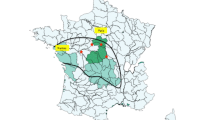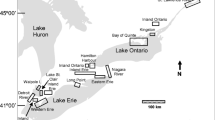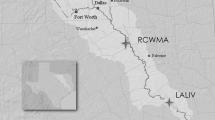Abstract
Liver samples (n = 43) of 9 avian species representing the families Phalacrocoracidae, Podicipedidae, Laridae, and Anatidae, were collected from the Iranian coast of the Caspian Sea. Samples were analyzed for organochlorine pesticides (OCPs), such as dichlorodiphenyltrichloroethane (DDT) and its metabolites, hexachlorobenzene (HCB), hexachlorocyclohexane isomers (HCHs), and seven PCB congeners. p,p′-DDE was predominantly found in all species, at concentrations ranging from the limit of quantification (LOQ) to 340 ng/g ww. Most frequently encountered PCB congeners, in all samples, were 118, 153 and 138; and birds in Phalacrocoracidae had the highest liver PCB (mean 90 ± 32; ranging from <LOQ to 106 ng/g ww) whereas Podicipedidae had the highest OCP (mean 147 ± 49; ranging from <LOQ to 340 ng/g ww) (P < 0.05). Differences in the diet, and migratory routes, were important species-specific factors that affected hepatic concentration of OCP and PCB in the species we studied. Range of OCP and PCB concentrations in the present study was lower than those reported for birds in other regions of the world. Hepatic PCB concentration found in our avian species was below toxic effect levels that have been previously reported in birds. To our knowledge this is the first report of persistent organochlorine pollutants in liver of birds from Iran.






Similar content being viewed by others
References
Aguilar A (1984) Relationship of DDE/ΣDDT in marine mammals to the chronology of DDT input into the ecosystem. Can J Fish Aquatic Sci 41:840–844
Barron MG, Galbraith H, Beltman D (1995) Comparative reproduction and developmental toxicology of birds. Comp Biochem Physiol 112:1–14
Blus LJ, Health RG, Gish CD, Belisle AA, Prouty RM (1971) Egg shell thinning in the brown pelican: implication of DDE. Bio sci 21:1213–1215
Bouwman H, Polder A, Venter B, Skaare JU (2008) Organochlorine contaminant in cormorant, darter, egret, and ibis eggs from South Africa. Chemosphere 71:227–241
Braune BM, Mallory ML, Gillchrist HG, Letcher RJ, Drouillard KG (2007) Levels and trends of organochlorines and brominated flame retardants in ivory gull egg from the Canadian Arctic, 1979 to 2004. Sci Total Environ 378:403–417
Choi JW, Matsuda M, Kawano M, Min BY, Wakimoto T (2001) Accumulation profiles of persistent organochlorines in waterbirds from an estuary in Korea. Chemosphere 41:353–363
Cid FD, Anton RI, Caviedes-Vidal E (2007) Organochlorine pesticide contamination in three bird species of the Embalse Lake Florida water reservoir in sediarid Midwest of Argentina. Sci Total Environ 385:86–96
Cleemann M, Riget F, Paulsen GB, Dietz R (2000a) Organochlorines in Greenland glaucous gulls (Larus hyperboreus) and Icelandic gulls (Larus glaucoides). Sci Total Environ 17(245(1–3)):117–130
Cleemann M, Riget F, Paulsen GB, Dietz R (2000b) Organochlorines in Greenland glauccous gull (Larus hyperboreus) and Icelandic gulls (Larus glaucoides). Sci Total Environ 254:117–130
Colborn T, Vom Sall FS, Soto AM (1993) Development effects of endocrine-disrupting chemicals in wild life and humans. Environ Health Perspect 101:378–384
Cook AS, Bell AA, Hass MB (1982) Predatory birds pesticides and pollution. Institute of Terrestrial Ecology, Cambridge
Dahmardeh Behrooz R, Esmaili-Sari A, Ghasempouri M, Bahramifar N, Covaci A (2009a) Organochlorine pesticide and polychlorinated biphenyl residues in feathers of birds from different trophic levels of South-West Iran. Environ Int 35:285–290
Dahmardeh Behrooz R, Esmaili-Sari A, Ghasempouri M, Bahramifar N, Hosseini M (2009b) Organochlorine pesticides and polychlorinated biphenyl in feathers of resident and migratory birds of south-west Iran. Archives Environ Contam Toxicol. doi:10.1007/s00244-008-9211-9
Dahmardeh Behrooz R, Esmaili-Sari A, Bahramifar N, Ghasempouri M (2009c) Organochlorine pesticide and polychlorinated biphenyl residues in human milk from the southern coast of Caspian sea, Iran. Chemosphere 74:931–937
Drooge BV, Mateo R, Vives I, Cardiel I, Guitart R (2008) Organochlorine residue levels in livers of birds of preys from Spain: inter-species comparison in relation with diet and migratory patterns. Environ Pollut 153:84–91
Eisler R (1986) Polychlorinated biphenyl hazards to fish, wildlife, and invertebrates: a synoptic review. U.S. Department of Interior, Biological Report 85, Contamination Hazard Review Report No.7
Elliot JE, Norstrom RJ (1998) Chlorinated hydrocarbon contaminants and productivity of bald eagle populations on the pacific coast of Canada. Environ Toxicol Chem 17:1142–1153
Faber RA, Hickey JJ (1973) Eggshell thinning, chlorinated hydrocarbons, and mercury in inland aquatic bird eggs, 1969 and 1970. Pestic Monit J 7:27–36
Fang L, Zheng M, Zhang B, Gao L, Liu W, Zhao X (2007) Polychlorinated dibenzo- p-dioxins and dibenzofurans in eggs of eight avian species from Dongting Lake, China. Chemosphere 69:411–421
Fossi M, Leonzio C, Focardi S, Lari L, Renzoni A (1991) Modulation of mixed-function oxidase activity in black-headed gulls living in anthropic environments: biochemical acclimatization or adaptation? Environ Toxicol Chem 10(1):179–188
Fossi MC, Massi A, Lari L, Marsili L, Focardi S, Leonzio C, Renzoni A (1995) Interspecies differences in mixed function oxidase activity in birds: relationship between feeding habits, detoxication activities and organochlorine accumulation. Environ Pollut 90:15–24
Furness RW (1993) Birds as monitors of pollutant. In: Furness RW Greenwood, JJD (eds) Birds as monitors of environmental changes. Chapman Hall, London, pp 86–143
Guruge KS, Tanabe S, Fukuda M (2000) Toxic assessment of PCBs by 2,3,7,8-tetrachlorodibenzo-dioxin equivalent in common cormorant (Phalacrocoracidae carbo) from Japan. Environ Contam Toxicol 38:509–521
Harris ML, Elliot JE, Butler RW, Wilson LK (2003) Reproductive success and chlorinated hydrocarbon contamination of great blue herons (Ardea herodias) from coastal British Columbia, Canada, 1977 to 2000. Environ Pollut 121:207–227
Heidari H (2003) Farmer field schools (FFS) slash pesticides use and exposure in Islamic Republic of Iran. Agro-chemicals Report; 1-3
Hosseini SV, Behrooz RD, Esmaili-Sari A, Bahramifar N, Hosseini SM, Tahergorabi R, Hosseini SF, Feas X (2008) Contamination by organochlorine compound in the edible tissue of four sturgeon species from the Caspian Sea (Iran). Chemosphere 73:272–279
Jaspers VLB, Covaci A, Voorspoels S, Dauwe T, Eens M, Schepens P (2006) Brominated flame retardants and organochlorine pollutants in aquatic and terrestrial predatory birds of Belgium: levels, pattern, tissue distribution and condition factors. Environ Pollut 139:340–352
Jaspers VLB, Voorspoels S, Covaci A, Lepoint G, Eens M (2007) Evaluation of the usefulness of bird feathers as a non-destructive biomonitoring tool for organic pollutants: a comparative and meta-analytical approach. Environ Int 33:328–337
Koeman JH, Vanvelzen-Bald HCW, Devries R, Vos JG (1973) Effects of PCB and DDE in cormorant and Evaluation of PCB residues from an experimental study. J Reprod Fertil Suppl 19:353–364
Kunisue T, Watanabe M, Subramanian A, Sethuraman A, Titenko AM, Qui V, Prudente M, Tanabe SH (2003) Accumulation features of persistent organochlorines in resident and migratory birds from Asia. Environ Pollut 125:157–172
Malcolm HM, Osborn D, Wright J, Wienburg CL, Sparks TH (2003) Polychlorinated biphenyl (PCB) congener concentrations in Seabirds found dead in mortality incidents around the British coast. Environ Contam Toxicol 45:136–147
Mansoori J (1999) Field guide to birds of Iran. University of Tehran, Iran
Murata M, Iseki N, Masunaga S, Nakanishi J (2003) Estimation of effects of dioxins and dioxin-like PCBs on wild life population—a case study on common cormorant. Chemosphere 53:337–345
Nakata H, Tanabe S, Tatsukawa R, Koyama Y, Miyazaki N, Belikov S, Boltunov A (1998) Persistent organochlorine contaminants in ringed Seals (Phoca hispida) from the Kara sea, Russian Arctic. Environ Toxicol Chem 17:1745–1755
Naso B, Perrone D, Ferrante MC, Zaccaroni A, Lucisano A (2003) Persistent organochlorine pollutants in liver of birds of different trophic levels from from coastal area of Campania, Italy. Environ Contam Toxicol 45:407–414
Nazari Z, Haghghi S, Eimandel K, Hosseini S, Parriz M, Kalantari H (2001) Determination of organochlorine pesticides residue in river to Caspian sea and sea station. In: Second national conference on optimum utilization of chemical fertilizers and pesticides in agriculture. Ministry of agriculture, Karaj, Islamic Republic of Iran
Newton I (1988) Determination of critical pollutants levels in wild population, with examples from organochlorine insecticides in birds of prey. Environ Pollut 55:29–40
Oliver BJ, Niimi AJ (1988) Trophodynamic analysis of polychlorinated biphenyl congeners and other chlorinated hydrocarbons in the Lake Ontario ecosystem. Environ Sci Technol 22:388–397
Peakall DB, Noble DG, Elliot JE, Somers JD, Erickson G (1990) Environmental contaminants in Canadian peregrine falcons, Falco peregrinus: a toxicological assessment. Can Field Nat 104:244–254
Provini A, Glassi S (1999) Polychlorinted biphenyls and chlorinated pesticides in bird eggs from Calabria (Southern Italy). Ecotoxicol Environ Saf 43:91–97
Sakellarides TM, Konstantantinou IK, Hela DG, Lambropoulou D, Dimou A, Albanis TA (2006) Accumulation profiles of persistent organochlorines in liver and fat tissues of various waterbird species from Greece. Chemosphere 63:1392–1409
Van den Berg M, Cranne BLHJ, Sinnige T, Van morik S, Dirksen S, Boudewijn T (1994) Biochemical and toxic effects of polychlorinated (PCBs), dibenzo-p-dioxins (PCDDs), and dibenzofurans (PCDFs) in the cormorant (phalacrocoracidae carbo) after in vivo exposure. Environ Toxicol Chem 13:803–816
Walker CH (2001) Organic pollutants—an ecotoxicological perspective. Taylor Francis, London
Watanabe M, Tanabe S, Tatsukawa R, Amano M, Miyazaki N, Petrov EA, Khuraskin SL (1999) Contamination levels and specific accumulation of persistent organochlorines in Caspian Seal (Phoca Caspica) from the Caspian Sea, Russia. Arch Environ Contam Toxicol 37:396–407
Wiemeyer SN, Spann JW, Bunck CM, Krynisky AJ (1989) Effect of kelthane on reproduction of captive eastern screech owls. Environ Toxicol Chem 8:903–913
Willett KL, Ulrich EM, Hites RA (1998) Different toxicity and environmental fates of hexachlorocyclohexane isomers. Environ Sci Technol 32:2197–2207
Yamashita N, Tanabe S, Ludwing JN, Kurita H, Ludwig ME, Tatsukawa R (1993) Embryonic abnormalities, organochlorine contamination in double-crested cormorants (Phalacrocorax auritus), caspian terns (Hydroprogne casppia) from the upper Great Lakes in 1988. Environ Pollut 79:163–173
Acknowledgments
Authors would like to acknowledge and thank Drs. J. Mansoori, and Hassanzadeh Kiabi for their help in identification of the birds. We are also grateful to Drs. Covaci and Dahmardeh-Behrooz for their critical review of this manuscript.
Author information
Authors and Affiliations
Corresponding author
Rights and permissions
About this article
Cite this article
Rajaei, F., Esmaili-Sari, A., Bahramifar, N. et al. Avian liver organochlorine and PCB from South coast of the Caspian Sea, Iran. Ecotoxicology 19, 329–337 (2010). https://doi.org/10.1007/s10646-009-0415-1
Accepted:
Published:
Issue Date:
DOI: https://doi.org/10.1007/s10646-009-0415-1




